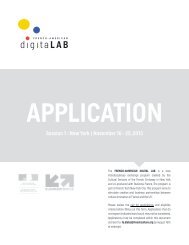REX
BD16_REX
BD16_REX
You also want an ePaper? Increase the reach of your titles
YUMPU automatically turns print PDFs into web optimized ePapers that Google loves.
Retours d’expériences Big Data en entreprise<br />
HP - AT&T<br />
AT&T LEVERAGES HP VERTICA ANALYTICS PLATFORM TO CHANGE<br />
THE ECONOMICS OF PROVIDING ACTIONABLE INSIGHTS TO<br />
DECISION MAKERS<br />
OVERVIEW<br />
AT&T has made Big Data analytics a core component of the business decision-making process to drive its growth<br />
and maximize customer satisfaction. In May 2013, the telecommunications company augmented its Enterprise<br />
Consolidated Data Warehouse with the HP Vertica Analytics Platform (HP Vertica) to improve the performance of<br />
critical analytics workloads. HP Vertica, a core engine of the HP HAVEn Big Data Platform, has surpassed AT&T’s<br />
expectations and is providing company decision makers with actionable insights into areas such as customer and<br />
network use patterns.<br />
John Yovanovich, Director of Data Strategy, Delivery, and Support at AT&T, explained that his company chose the<br />
HP Vertica Analytics Platform after concluding that “we needed a platform that supported the columnar database<br />
technology required by critical workloads.” This conclusion reflected the increasingly<br />
prominent position of Big Data analytics at AT&T and the potential value the company sees in it.<br />
Yovanovich credits HP Vertica with changing how analytics are consumed and used by AT&T’s lines of business<br />
(LOBs). Above all, his internal LOB clients demand a robust analytics platform that can<br />
run required queries quickly and efficiently. Before deploying HP Vertica, AT&T could not fully exploit the potential<br />
of Big Data analytics because of the cost and time associated with running certain queries on its legacy platform.<br />
With HP Vertica, Yovanovich’s team provides superior outputs at a much lower cost, so business teams are bringing<br />
many more projects to his team.<br />
Yovanovich cited a number of ways in which HP Vertica drives value for AT&T. From the onset, the move avoided<br />
investment costs of $11 million in pending capacity expansion. Business decision makers get query results in less<br />
time and can run more complex queries and analyses. As such, they have more actionable information in their hands<br />
sooner, which helps them craft improved business strategies and make better decisions. This results in improved<br />
services for AT&T’s customers, improved customer relationships, and operational efficiencies.<br />
Meanwhile, Yovanovich’s team has benefited from the speed with which HP Vertica runs queries and its ease of use;<br />
he estimates that teams responsible for preparing and carrying out data queries have become roughly 20% more productive<br />
since deploying HP Vertica. Finally, AT&T is paying much less to run analytics workloads on HP Vertica than it<br />
was paying to run analytics workloads on its legacy platform. This allows business units to migrate certain workloads<br />
to HP Vertica and pay much less even as the quality and speed of the outputs improve substantially.<br />
Based on discussions with Yovanovich, IDC calculates that AT&T is achieving discounted benefits of<br />
$63.38 million over five years with its to-date deployment of 570TB of data on HP Vertica, including cost savings<br />
on analytical queries compared with its legacy row-based analytics platform, costs avoided for increasing its legacy<br />
platform’s capabilities, more efficient retention of data, and improved productivity for its data analytics team. Over a<br />
projected five-year period, this results in a return on investment (ROI) of 657% and a payback period of 4.0 months.<br />
IMPLEMENTATION<br />
AT&T’s Big Data strategy is centered on leveraging the voluminous customer use data that feeds into the company’s<br />
Enterprise Consolidated Data Warehouse to create actionable insights and ultimately business advantages.<br />
As of October 2014, the warehouse employs 3.2PB of storage in total and supports all of AT&T’s home and business<br />
solutions product and service lines. The foundation of AT&T’s Big Data strategy is to feed this huge amount<br />
of information — more than 100 million files an hour flow from AT&T cellular towers alone — into shared relational<br />
databases and then move this data into the data warehouse via the Hadoop open source software framework for<br />
analysis driven by analytics platforms.<br />
Two years ago, AT&T began evaluating columnar-based analytics engines after concluding that performance limitations<br />
with its legacy row-based analytics solution would prevent it from fully leveraging data to drive its business.<br />
It had discovered that it could not economically run many of the complex data queries and analyses requested by<br />
its LOBs on its legacy row-based analytics platform. As a result, AT&T sought a more robust, query-oriented analytics<br />
platform with columnar-based analytics technology to enable it to handle more complex queries and handle<br />
queries more efficiently.<br />
AT&T carried out a proof of concept with several Big Data analytics engines and found that HP Vertica came out<br />
on top in both performance and cost. “No one came close to HP Vertica on price,” Yovanovich said. “We also liked<br />
the fact that they are a market leader in columnar database technology with a proven track record among largevolume<br />
customers like us.”<br />
Document réalisé par la Société Corp Events - Janvier 2015<br />
36







